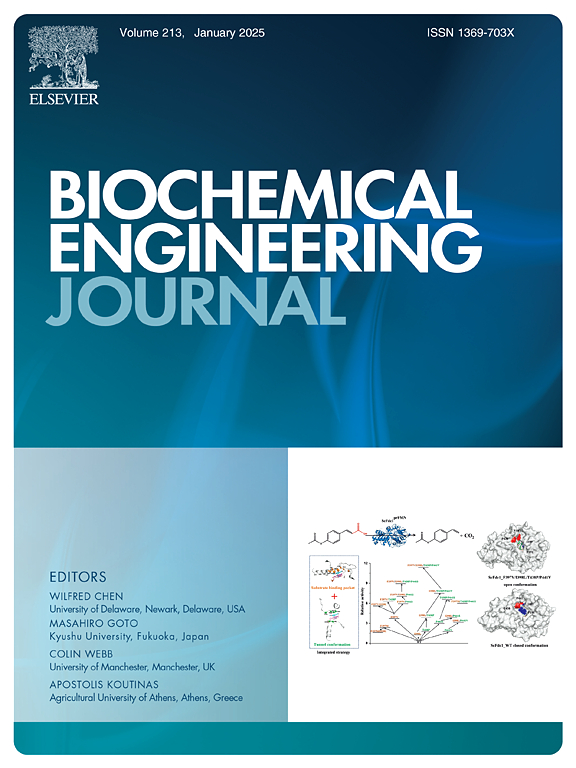Enhancing anaerobic digestion performance of food-waste solid residue through alkali-thermal pretreatment
IF 3.7
3区 生物学
Q2 BIOTECHNOLOGY & APPLIED MICROBIOLOGY
引用次数: 0
Abstract
The resource utilization of food-waste solid residue has received much attention, but the high organic content has resulted in poor hydrolysis performance during anaerobic digestion. In this study, pretreated food-waste solid residues through alkali, thermal and alkali-thermal were mixed with excess sludge for anaerobic digestion. Results indicated that pretreatments significantly alleviated the inhibitory effect of NH4+-N and stabilized the pH of the digestive environment. Under the condition of alkali-thermal group, the concentrations of soluble chemical oxygen demand (SCOD), soluble protein, soluble polysaccharide and Volatile fatty acids (VFAs) were degraded by 81.00 %, 53.02 %, 42.87 % and 99.99 %, respectively, compared to the condition of control group. The absolute abundance advantage of Dojkabacteria significantly reduced the risk of ammonia inhibition and the relative abundance of Methanobacterium archaea was nearly 90 % under the condition of alkali-thermal group. It was observed that substrate was fragmented and enriched with bacilli and cocci in the crevices after the reaction under the condition of alkali-thermal group. The pretreatment was effective in utilizing more DOM, thereby increasing the efficiency of methane production. The condition of alkali-thermal group had the highest methanogenic potential, which was 16.78 % and 34.04 % more than alkali group and thermal group, respectively, and the maximum methane production rate was at its highest (Rmax =522.70 mL/d). Compared to the condition of control group, the cumulative methane productions increased by 685.90 %, 593.71 % and 847.07 % under the conditions of alkali group, thermal group and alkali-thermal group, respectively. This founding provided an effective way for resource utilization of food-waste solid residue.
碱热预处理提高餐厨垃圾固体残渣厌氧消化性能
食物垃圾固体残渣的资源化利用备受关注,但由于其有机含量过高,导致其在厌氧消化过程中的水解性能较差。本研究将经碱、热、碱热预处理的厨余固体残渣与剩余污泥混合进行厌氧消化。结果表明,预处理显著缓解了NH4+-N的抑制作用,稳定了消化环境的pH。在碱热组条件下,可溶性化学需氧量(SCOD)、可溶性蛋白质、可溶性多糖和挥发性脂肪酸(VFAs)的浓度分别比对照组降低了81.00 %、53.02 %、42.87 %和99.99 %。dojkabobacteria的绝对丰度优势显著降低了氨抑制的风险,在碱-热组条件下,古甲烷菌的相对丰度接近90 %。在碱-热组条件下反应后,底物呈破碎状,裂缝中富含杆菌和球菌。预处理有效地利用了更多的DOM,从而提高了产甲烷效率。碱-热组产甲烷潜力最大,分别比碱组和热组高16.78 %和34.04 %,最大产甲烷率最高(Rmax =522.70 mL/d)。与对照组相比,碱组、热组和碱-热组的累计甲烷产量分别提高了685.90 %、593.71 %和847.07 %。这一发现为食物垃圾固体渣资源化利用提供了有效途径。
本文章由计算机程序翻译,如有差异,请以英文原文为准。
求助全文
约1分钟内获得全文
求助全文
来源期刊

Biochemical Engineering Journal
工程技术-工程:化工
CiteScore
7.10
自引率
5.10%
发文量
380
审稿时长
34 days
期刊介绍:
The Biochemical Engineering Journal aims to promote progress in the crucial chemical engineering aspects of the development of biological processes associated with everything from raw materials preparation to product recovery relevant to industries as diverse as medical/healthcare, industrial biotechnology, and environmental biotechnology.
The Journal welcomes full length original research papers, short communications, and review papers* in the following research fields:
Biocatalysis (enzyme or microbial) and biotransformations, including immobilized biocatalyst preparation and kinetics
Biosensors and Biodevices including biofabrication and novel fuel cell development
Bioseparations including scale-up and protein refolding/renaturation
Environmental Bioengineering including bioconversion, bioremediation, and microbial fuel cells
Bioreactor Systems including characterization, optimization and scale-up
Bioresources and Biorefinery Engineering including biomass conversion, biofuels, bioenergy, and optimization
Industrial Biotechnology including specialty chemicals, platform chemicals and neutraceuticals
Biomaterials and Tissue Engineering including bioartificial organs, cell encapsulation, and controlled release
Cell Culture Engineering (plant, animal or insect cells) including viral vectors, monoclonal antibodies, recombinant proteins, vaccines, and secondary metabolites
Cell Therapies and Stem Cells including pluripotent, mesenchymal and hematopoietic stem cells; immunotherapies; tissue-specific differentiation; and cryopreservation
Metabolic Engineering, Systems and Synthetic Biology including OMICS, bioinformatics, in silico biology, and metabolic flux analysis
Protein Engineering including enzyme engineering and directed evolution.
 求助内容:
求助内容: 应助结果提醒方式:
应助结果提醒方式:


